泛函分析结课论文资料
泛函分析课程论文
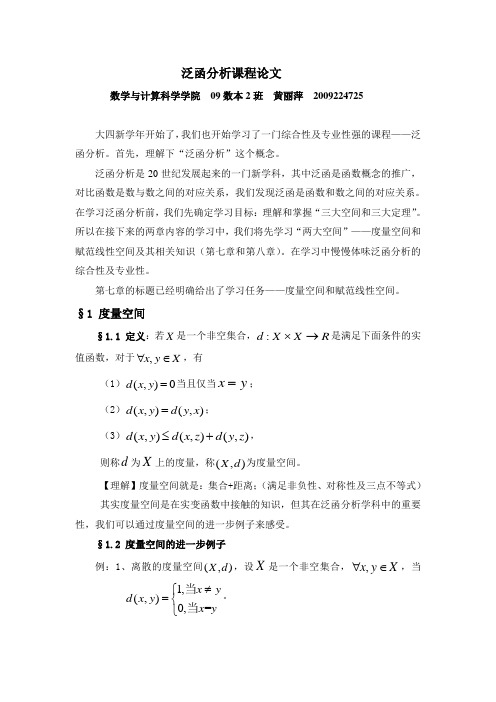
泛函分析课程论文数学与计算科学学院 09数本2班 黄丽萍 2009224725大四新学年开始了,我们也开始学习了一门综合性及专业性强的课程——泛函分析。
首先,理解下“泛函分析”这个概念。
泛函分析是20世纪发展起来的一门新学科,其中泛函是函数概念的推广,对比函数是数与数之间的对应关系,我们发现泛函是函数和数之间的对应关系。
在学习泛函分析前,我们先确定学习目标:理解和掌握“三大空间和三大定理”。
所以在接下来的两章内容的学习中,我们将先学习“两大空间”——度量空间和赋范线性空间及其相关知识(第七章和第八章)。
在学习中慢慢体味泛函分析的综合性及专业性。
第七章的标题已经明确给出了学习任务——度量空间和赋范线性空间。
§1 度量空间§1.1 定义:若X 是一个非空集合,:d X XR ⨯→是满足下面条件的实值函数,对于,x y X ∀∈,有(1)(,)0d x y =当且仅当xy =;(2)(,)(,)d x y d y x =;(3)(,)(,)(,)d x y d x z d y z ≤+,则称d 为X 上的度量,称(,)X d 为度量空间。
【理解】度量空间就是:集合+距离;(满足非负性、对称性及三点不等式) 其实度量空间是在实变函数中接触的知识,但其在泛函分析学科中的重要性,我们可以通过度量空间的进一步例子来感受。
§1.2 度量空间的进一步例子例:1、离散的度量空间(,)X d ,设X 是一个非空集合,,x y X ∀∈,当1,(,)0,=x y d x y x y≠⎧=⎨⎩当当。
2、序列空间S ,i =1i |-|1(,)21+|-|i i i i d x y ξηξη∞=∑是度量空间 3、有界函数全体()B A ,(,)sup|(t)-(t)|t Ad x y x y ∈=是度量空间4、连续函数[a,b]C ,(,)max|(t)-(t)|a t bd x y x y ≤≤=是度量空间5、空间2l ,122=1(,)[(-)]k ki d x y y x ∞=∑是度量空间§1.3度量空间中的极限,稠密集,可分空间§1.3.1极限:类似数学分析定义极限,如果{}n x 是(,)X d 中点列,如果∃x X ∈,使n l im (,)=0n d x x →∞,则称点列{}n x 是(,)X d 中的收敛点列,x 是点列{}n x 的极限。
泛函分析课程总结论文
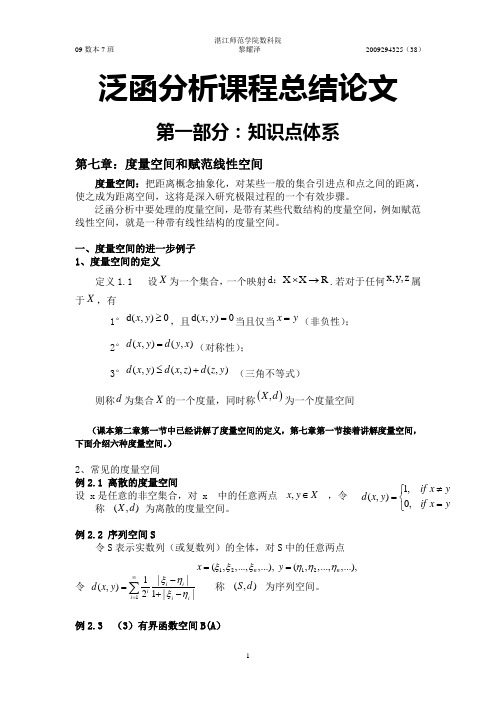
泛函分析课程总结论文第一部分:知识点体系第七章:度量空间和赋范线性空间度量空间:把距离概念抽象化,对某些一般的集合引进点和点之间的距离,使之成为距离空间,这将是深入研究极限过程的一个有效步骤。
泛函分析中要处理的度量空间,是带有某些代数结构的度量空间,例如赋范线性空间,就是一种带有线性结构的度量空间。
一、度量空间的进一步例子 1、度量空间的定义定义1.1 设X 为一个集合,一个映射X X R ⨯→d :.若对于任何x,y,z 属于X ,有1°d(,)0x y ≥,且d(,)0x y =当且仅当x y =(非负性); 2°(,)(,)d x y d y x =(对称性);3°(,)(,)(,)d x y d x z d z y ≤+ (三角不等式) 则称d 为集合X 的一个度量,同时称(),X d 为一个度量空间(课本第二章第一节中已经讲解了度量空间的定义,第七章第一节接着讲解度量空间,下面介绍六种度量空间。
)2、常见的度量空间 例2.1 离散的度量空间设 x 是任意的非空集合,对 x 中的任意两点 ,令 称为离散的度量空间。
例2.2 序列空间S令S 表示实数列(或复数列)的全体,对S 中的任意两点令 称为序列空间。
例2.3 (3)有界函数空间B(A ),x y X ∈1,(,)0,if x yd x y if x y ≠⎧=⎨=⎩(,)X d 1212(,,...,,...),(,,...,,...),n n x y ξξξηηη==1||1(,)21||i i i i i id x y ξηξη∞=-=+-∑(,)S d设A 是一个给定的集合,令B(A)表示A 上有界实值(或复值)函数全体,对B(A)中任意两点x,y ,定义例2.4 可测函数空间设M(X)为X 上实值(或复值)的勒贝格可测函数全体,m 为勒贝格测度,若,对任意两个可测函数 及 由于 ,所以这是X 上的可积函数。
电子信息类专业导论结课论文
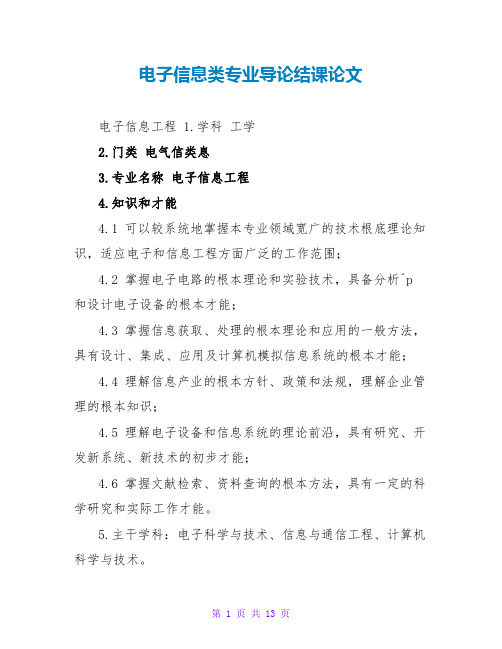
电子信息类专业导论结课论文电子信息工程 1.学科工学2.门类电气信类息3.专业名称电子信息工程4.知识和才能4.1 可以较系统地掌握本专业领域宽广的技术根底理论知识,适应电子和信息工程方面广泛的工作范围;4.2 掌握电子电路的根本理论和实验技术,具备分析^p 和设计电子设备的根本才能;4.3 掌握信息获取、处理的根本理论和应用的一般方法,具有设计、集成、应用及计算机模拟信息系统的根本才能;4.4 理解信息产业的根本方针、政策和法规,理解企业管理的根本知识;4.5 理解电子设备和信息系统的理论前沿,具有研究、开发新系统、新技术的初步才能;4.6 掌握文献检索、资料查询的根本方法,具有一定的科学研究和实际工作才能。
5.主干学科:电子科学与技术、信息与通信工程、计算机科学与技术。
6.主要课程:电路理论系列课程、计算机技术系列课程、信息理论与编码、信号与系统、数字信号处理、电磁场理论、自动控制原理、感测技术等。
主要理论性教学环节:包括课程实验、计算机上机训练、课程设计、消费实习、毕业设计等。
一般要务理论教学环节不少于30周。
- 1 -7.修业年限:四年8.授予学位:工学学士9.专业简介9.1 电子信息工程是一门应用计算机等现代化技术进展电子信息控制和信息处理的学科,主要研究信息的获取与处理,电子设备与信息系统的设计、开发、应用和集成。
如今,电子信息工程已经涵盖了社会的诸多方面,像交换局里怎么处理各种信息,手机是怎样传递我们的声音甚至图像的,我们周围的网络怎样传递数据,甚至信息化时代军队的信息传递中如何保密等都要涉及电子信息工程的应用技术。
我们可以通过一些根底知识的学习认识这些东西,并可以应用更先进的技术进展新产品的研究和创造9.2 电子信息工程专业是集现代电子技术、信息技术、通信技术于一体的专业。
本专业培养掌握现代电子技术理论、通晓电子系统设计原理与设计方法,具有较强的计算机、外语和相应工程技术应用才能,面向电子技术、自动控制和智能控制、计算机与网络技术等电子、信息、通信领域的宽口径、高素质、德智体全面开展的具有创新才能的高级工程技术人才开发。
专业导论结课论文
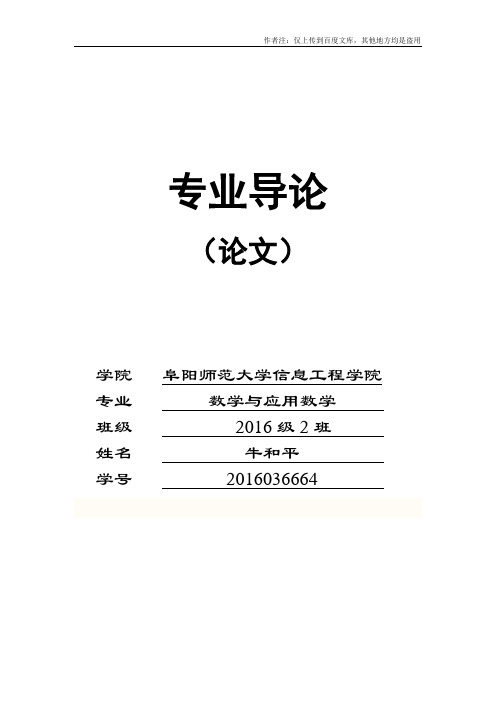
专业导论(论文)学院阜阳师范大学信息工程学院专业数学与应用数学班级2016级2班姓名牛和平学号2016036664题记:数学是无穷的科学. ——赫尔曼外尔“越往前走,艺术越要科学化,同时科学也要艺术化,两者从山麓分手,又从山顶会合。
”步入大学,琳琅满目的学科门类使我迷惘与彷徨,阴差阳错考入了阜阳师范大学信息工程学院中的数学与应用数学专业,面对这个我一无所知的专业,我感到对未来的恐惧。
可是来到了信工,接触了数学,才发现数学原来充满了神秘与乐趣。
并且对数学与应用数学专业也有了更深的认识,应用数学专业学生主要学习数学和应用数学的基础理论、基本方法,受到数学模型、计算机和数学软件方面的基本训练,具有较好的科学素养,初步具备科学研究、教学、解决实际问题及开发软件等方面的基本能力。
数学与应用数学是计算机专业的基础和上升的平台,是与计算机科学与技术联系最为紧密的专业之一。
通过对专业的进一步了解,我对专业的前景有了更深的认识。
毕业生多数经过进一步深造后,进入国内外大学和研究机构,从事高等研究,主要方向为数学、计算机、信息科学、金融与管理科学等。
以后直接进入研究机构、公司从事分析、应用等方面的工作。
虽然数学与应用数学专业学习难度很大,就业前景也是不很突出,但既然已经开始了数学之路,就应该寻找适合自己的方式走下去。
我个人在高中时就比较偏爱计算机与金融,高考时也曾想报金融方面的专业,但由于分数受限,没有如愿以偿。
数学是一切学科的基础,所以比其它学科更有优势考研。
我对自己的未来规划是考计算机或金融方向的研究生,许多软件公司再招生的时候倾向于要应数专业的,方法比专业更重要,应数学习的就是方法,万金油专业,学其他的上手快,这也是数学专业的优势之一。
而且我虽然不是很偏爱数学,但数学的确充满了神秘感和奥秘。
记得最后一节专业导论课是尚友林院长给我们上的,他给我们讲了几个关于数学的千古难题,我印象最深的是哥德巴赫猜想,后来通关查阅相关资料,知道了这个猜想的大致内容。
泛函分析期中课程论文(2012.11)

湛江师范学院2012 年-2013 学年度第 1 学期
期中考核题目及评分标准
考查科目:泛函分析授课对象:数科院09数本1-9班
任课教师:栾姝
考核形式:课程论文
具体要求:课程论文应包括以下两方面内容:一、总结《泛函分析》课程的知识体系;二、列举泛函分析中的某个知识点在其
他课程中的应用。
文中如涉及他人论文内容,要列出参考
文献。
题目自拟。
A4纸单面打印(标明院系、专业、班级、
姓名、学号) 字体:小四字数:不限
评分标准:100-90分:一、知识点总结详尽、准确,特别应注重每章
中各个知识点之间的区别和联系,要有自己的
独到之处。
二、要通过查阅参考文献,全面、
系统地总结泛函分析中某个知识点在其他课
程中的应用。
89-80分:一、知识点总结较为详尽、准确,基本体现各
个知识点之间的区别和联系,有自己的观点。
二、通过查阅参考文献,较为全面地总结了泛
函分析中某个知识点在其他课程中的应用。
79-70分:一、知识点总结基本全面、部分知识点内在联系
总结基本准确。
二、文中体现了泛函分析中某
个知识点在其他课程中的应用。
69-60分:一、知识点总结相对不够全面、部分知识点内在联
系总结基本准确。
二、文中有涉及到泛函分析
中某个知识点在其他课程中的应用。
59-0分:一、知识点总结不够全面、部分知识点内在联系总结
不够准确或者完全没有涉及,只是罗列课本中
的内容,没有自己的观点。
二、文中没有涉及
到泛函分析中某个知识点在其他课程中的应
用。
泛函分析期末复习提要.doc

泛函分析期末复习提要一、距离空间与拓扑空间(一)教学内容1.距离空间的基本概念:定义与例子、收敛性、距离空间的连续映射与等距。
2.距离空间中的点集:开集与闭集、稠密子集,可分距离空间。
3.完备距离空间:Cauc/巧列,完备性、闭球套定理、纲,纲定理、距离空间完备化。
4.压缩映射原理:不动点,压缩映射原理、压缩原理的一些应用。
5.拓扑空间的基本概:拓扑空间的定义、拓扑基、拓扑空间中的连续映射, 同胚、分离公理。
6.紧性和距离空间的紧性:紧性的概念、紧空间的连续映射。
7.距离空间的紧性:列紧集,全有界集、Arzela定理。
重点掌握距离空间的基本概念、距离空间中的点集、完备距离空间、压缩映射原理、拓扑空间的基本概念、紧性和距离空间的紧性。
难点完备距离空间、压缩映射原理。
(-)教学基本要求1・理解距离空间、距离空间中的点集等基木概念。
2•了解完备距离空间的概念,掌握压缩映射原理的证明。
3.理解拓扑空间的基木概念及其运算性质。
二、赋范线性空间(一)教学内容1.赋范空间的基本概念:赋范空间的定义、赋范空间的基本性、凸集、赋范空间的例。
2.空间L p(p>\):Holder不等式与Minkowski不等式、空间r(E)(p>i).空间r(E)o3•赋范空间进一步的性质:赋范空间的子空间、赋范空间的完备化、赋范空间的商空间、赋范空间的乘积、赋范线性空间的基本概念、等价范数。
4.有穷维赋范空间。
重点赋范空间的定义、赋范空间的基本性、凸集、赋范空间的例、Holder 不等式与Minkowski不等式、空间(£)(/?> 1) >空间匕(E)、赋范空间的子空间、赋范空间的完备化、赋范空间的商空间、赋范空间的乘积、赋范线性空间的基本概念、等价范数。
难点Holder不等式与Minkowski不等式、赋范空间的完备化、空间r(E)(p>i).空间r(E)o(-)教学基本要求1•理解赋范空间的定义、赋范空间的基本性、凸集、赋范空间的子空间、赋范线性空间的基本概念、等价范数。
泛函分析课程总结

泛函分析课程总结数学与计算科学学院 09数本5班 符翠艳 2009224524 序号:26 一.知识总结 第七章 度量空间和赋范线性空间 1. 度量空间的定义:设X 是一个集合,若对于X 中任意两个元素,x y ,都有唯一确定的实数(),d x y 与之相对应,而且满足()()()()()()()1,0,,0=;2,,;3,,,,d x y d x y x y d x y d y x d x y d x z d z y z ≥=⎧⎫⎪⎪=⎨⎬⎪⎪≤+⎩⎭、的充要条件是、、对任意都成立。
则称d 为X 上的一个度量函数,(d X ,)为度量空间,),(y x d 为y x ,两点间的度量。
2. 度量空间的例子①离散的度量空间(),X d设X 是任意的非空集合,对X 中任意两点,x y X ∈,令()1,,0,x y d x y x y ≠⎧⎫=⎨⎬=⎩⎭当当②序列空间S令S 表示实数列(或复数列)的全体,对S 中任意两点()()12n 12,,...,,...,,...,,...n x y ξξξηηη==及,令()11,21i ii i i i d x y ξηξη∞=-=+-∑③有界函数空间B (A )设A 是一给定的集合,令B (A )表示A 上有界实值(或复值)函数全体,对B (A )中任意两点,x y ,定义(),()()sup t Ad x y x t y t ∈=-④可测函数空间m(X)设m(X)为X 上实值(或复值)的L 可测函数全体,m 为L 测度,若()m X ≤∞,对任意两个可测函数()()f t g t 及,令()()(),1()()Xf tg t d f g dt f t g t -=+-⎰⑤[],C a b 空间令[],C a b 表示闭区间[],a b 上实值(或复值)连续函数的全体,对[],C a b 中任意两点,x y ,定义(),max ()()a t bd x y x t y t ≤≤=-⑥2l 空间 记{}12k k k x x x l ⎧⎫⎪⎪⎨⎬⎪⎪⎩⎭∞===<∞∑,设2k x x l ⎧⎫⎨⎬⎩⎭∈=,2y k y l ⎧⎫⎨⎬⎩⎭∈=,定义 ()1221,()k k k d x y y x ∞=⎡⎤=-⎢⎥⎣⎦∑注:度量空间中距离的定义是关键。
(完整)泛函分析知识总结,推荐文档
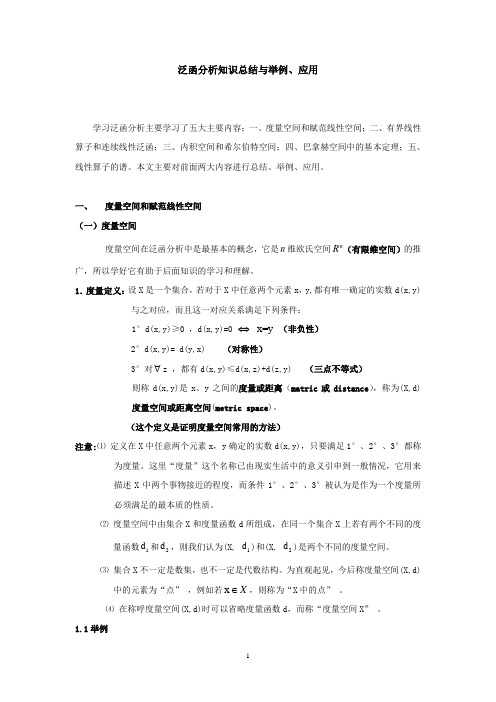
泛函分析知识总结与举例、应用学习泛函分析主要学习了五大主要内容:一、度量空间和赋范线性空间;二、有界线性算子和连续线性泛函;三、内积空间和希尔伯特空间;四、巴拿赫空间中的基本定理;五、线性算子的谱。
本文主要对前面两大内容进行总结、举例、应用。
一、 度量空间和赋范线性空间(一)度量空间度量空间在泛函分析中是最基本的概念,它是n 维欧氏空间n R (有限维空间)的推 广,所以学好它有助于后面知识的学习和理解。
1.度量定义:设X 是一个集合,若对于X 中任意两个元素x ,y,都有唯一确定的实数d(x,y)与之对应,而且这一对应关系满足下列条件:1°d(x,y)≥0 ,d(x,y)=0 ⇔ x=y (非负性)2°d(x,y)= d(y,x) (对称性)3°对∀z ,都有d(x,y)≤d(x,z)+d(z,y) (三点不等式)则称d(x,y)是x 、y 之间的度量或距离(matric 或distance ),称为(X,d)度量空间或距离空间(metric space )。
(这个定义是证明度量空间常用的方法)注意:⑴ 定义在X 中任意两个元素x ,y 确定的实数d(x,y),只要满足1°、2°、3°都称为度量。
这里“度量”这个名称已由现实生活中的意义引申到一般情况,它用来描述X 中两个事物接近的程度,而条件1°、2°、3°被认为是作为一个度量所必须满足的最本质的性质。
⑵ 度量空间中由集合X 和度量函数d 所组成,在同一个集合X 上若有两个不同的度量函数1d 和2d ,则我们认为(X, 1d )和(X, 2d )是两个不同的度量空间。
⑶ 集合X 不一定是数集,也不一定是代数结构。
为直观起见,今后称度量空间(X,d)中的元素为“点” ,例如若x X ∈,则称为“X 中的点” 。
⑷ 在称呼度量空间(X,d)时可以省略度量函数d ,而称“度量空间X ” 。
有限元法发展综述及其特点
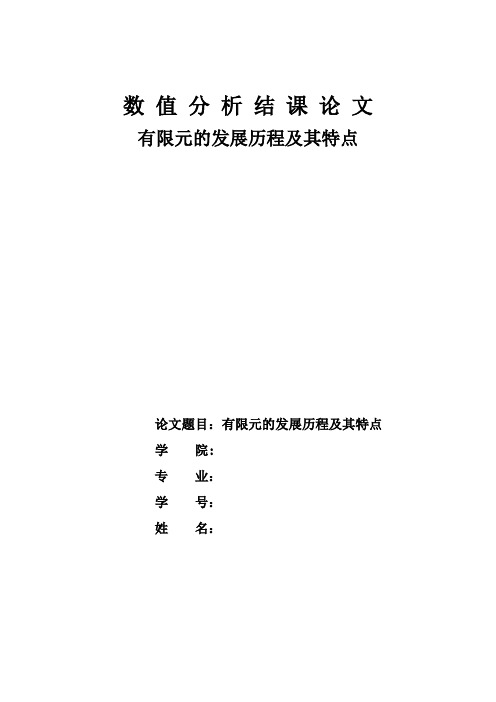
数值分析结课论文有限元的发展历程及其特点论文题目:有限元的发展历程及其特点学院:专业:学号:姓名:有限元法发展综述及其特点摘要:1965年“有限元”这个名词第一次出现,到今天有限元在工程上得到广泛应用,经历了三十多年的发展历史,理论和算法都已经日趋完善。
有限元的核心思想是结构的离散化,就是将实际结构假想地离散为有限数目的规则单元组合体,实际结构的物理性能可以通过对离散体进行分析,得出满足工程精度的近似结果来替代对实际结构的分析,这样可以解决很多实际工程需要解决而理论分析又无法解决的复杂问题。
关键词:有限元,积分法,加权余值法,边值,伽辽金(Galerkin)法。
引言有限元法是一种高效能、常用的计算方法.有限元法在早期是以变分原理为基础发展起来的,所以它广泛地应用于以拉普拉斯方程和泊松方程所描述的各类物理场中(这类场与泛函的极值问题有着紧密的联系)。
自从1969年以来,某些学者在流体力学中应用加权余数法中的迦辽金法(Galerkin)或最小二乘法等同样获得了有限元方程,因而有限元法可应用于以任何微分方程所描述的各类物理场中,而不再要求这类物理场和泛函的极值问题有所联系.有限元法的孕育过程及诞生和发展大约在300年前,牛顿和莱布尼茨发明了积分法,证明了该运算具有整体对局部的可加性。
虽然,积分运算与有限元技术对定义域的划分是不同的,前者进行无限划分而后者进行有限划分,但积分运算为实现有限元技术准备好了一个理论基础。
在牛顿之后约一百年,著名数学家高斯提出了加权余值法及线性代数方程组的解法。
这两项成果的前者被用来将微分方程改写为积分表达式,后者被用来求解有限元法所得出的代数方程组。
在18世纪,另一位数学家拉格郎日提出泛函分析。
泛函分析是将偏微分方程改写为积分表达式的另一途经。
在19世纪末及20世纪初,数学家瑞雷和里兹首先提出可对全定义域运用展开函数来表达其上的未知函数。
1915年,数学家伽辽金提出了选择展开函数中形函数的伽辽金法,该方法被广泛地用于有限元。
数学专业导论心得体会

数学专业导论心得体会篇一:金融学导论心得体会金融学导论心得体会125051138 张跃茹中学时期,完全未接触过金融学方面知识,且大学课程学习与高中的确有着相当大的不同;而且,大一上学期,专业课程开设很少,对自己所学的专业:金融学,只有一个模糊的概念。
下学期,开设了较多的专业基础课,此时,学校开设了金融学导论这门课,感觉很及时、很有帮助。
课上不仅详细讲了防灾金融专业要学的课程,消除了我对大一学完高数,大二学完英语,就逃离数学英语了,就彻底解放了。
现在才知道,大二要学线性代数,之后还有保险精算,计量经济,看来好好学习高数,要打好基础,不能考完了事;英语也一样,大三要还学金融学英语,单词什么的也不能忘了。
不能到考研时才重拾。
学习了金融学独特的研究方法:实证分析与规范分析;经济模型分析;案例分析。
简单介绍了金融学的重要理论:有效金融市场理论;证券组合理论;M&M定理;资本资产定价模型(CAPM);套利定价模式(APT);项目的价值分析(NPV);感觉好晕,突然发现金融学的确不怎么好学,以为没有物理就会非常容易学的想法是错误的。
了解了可以考的各种资格证,基础的,如:会计、银行、证券、保险从业资格证,每种证,考试会考哪些科目,考证不可能依赖课堂学习,必须培养自己自学能力。
老师就顺便讲了如何更好的学习金融学,有哪些网站、哪些论坛可以去,比如人大经济论坛;可以看一些公开课视频,在网易可以看到,是世界各地专家的一些公开课;哪些相关专业书籍可以看,书中讲了什么观点。
推荐了一些适合我们的、可以在课外学习的方式。
还有一些高级点的资格证,渐渐有了自己的目标。
决定要考什么,什么时候考。
更详细的介绍了前几届学长学姐的考研情况,和其中考研成绩出色的学长学姐的考研复习备考经验,要从大三的暑假开始复习准备,拿出高考时的精神动力。
看到他们考研的成绩,更加确切明白了高数的重要性,数学像江苏高考一样重要,“得数学者,得天下”。
要好好学习数学,看出来英语不好考,专业课,到不会太卡人。
泛函分析论文

泛函分析论文泛函分析是20世纪30年代形成的数学分科。
是从变分问题,积分方程和理论物理的研究中发展起来的。
它综合运用函数论,几何学,现代数学的观点来研究无限维向量空间上的函数,算子和极限理论。
它可以看作无限维向量空间的解析几何及数学分析。
主要内容有拓扑线性空间等。
泛函分析在数学物理方程,概率论,计算数学等分科中都有应用,也是研究具有无限个自由度的物理系统的数学工具。
泛函分析是研究拓扑线性空间到拓扑线性空间之间满足各种拓扑和代数条件的映射的分支学科。
泛函分析(Functional Analysis)是现代数学的一个分支,隶属于分析学,其研究的主要对象是函数构成的空间。
泛函分析是由对变换(如傅立叶变换等)的性质的研究和对微分方程以及积分方程的研究发展而来的。
使用泛函作为表述源自变分法,代表作用于函数的函数。
巴拿赫(Stefan Banach)是泛函分析理论的主要奠基人之一,而数学家兼物理学家伏尔泰拉(Vito Volterra)对泛函分析的广泛应用有重要贡献泛函分析是分析数学中最“年轻”的分支,它是古典分析观点的推广,它综合函数论、几何和代数的观点研究无穷维向量空间上的函数、算子、和极限理论。
他在二十世纪四十到五十年代就已经成为一门理论完备、内容丰富的数学学科了。
一、度量空间和赋范线性空间1、度量空间现代数学中一种基本的、重要的、最接近于欧几里得空间的抽象空间。
19世纪末叶,德国数学家G.康托尔创立了集合论,为各种抽象空间的建立奠定了基础。
20世纪初期,法国数学家M.-R.弗雷歇发现许多分析学的成果从更抽象的观点看来,都涉及函数间的距离关系,从而抽象出度量空间的概念。
度量空间中最符合我们对于现实直观理解的是三维欧氏空间。
这个空间中的欧几里德度量定义两点之间距离为连接这两点的直线的长度。
定义:设X为一个集合,一个映射d:X×X→R。
若对于任何x,y,z属于X,有(I)(正定性)d(x,y)≥0,且d(x,y)=0当且仅当 x = y;(II)(对称性)d(x,y)=d(y,x);(III)(三角不等式)d(x,z)≤d(x,y)+d(y,z)则称d为集合X的一个度量(或距离)。
【专业文档】泛函分析论文.doc
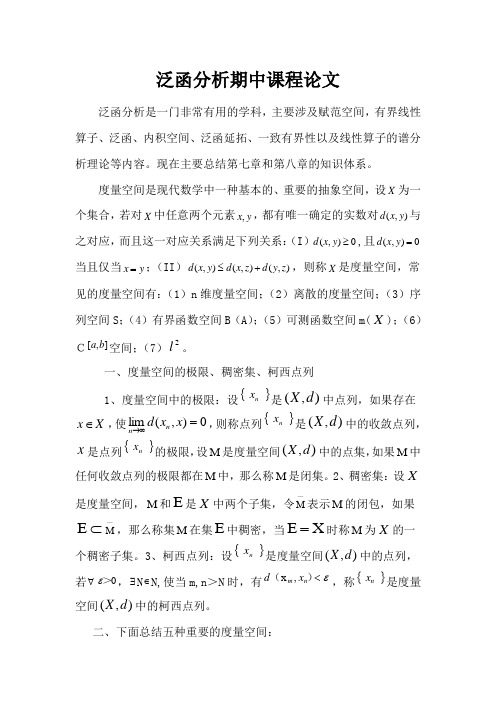
泛函分析期中课程论文泛函分析是一门非常有用的学科,主要涉及赋范空间,有界线性算子、泛函、内积空间、泛函延拓、一致有界性以及线性算子的谱分析理论等内容。
现在主要总结第七章和第八章的知识体系。
度量空间是现代数学中一种基本的、重要的抽象空间,设X 为一个集合,若对X 中任意两个元素y x ,,都有唯一确定的实数对),(y x d 与之对应,而且这一对应关系满足下列关系:(I )0),(≥y x d ,且0),(=y x d 当且仅当y x =;(II )),(),(),(z y d z x d y x d +≤,则称X 是度量空间,常见的度量空间有:(1)n 维度量空间;(2)离散的度量空间;(3)序列空间S ;(4)有界函数空间B (A );(5)可测函数空间m(X );(6)C],[b a 空间;(7)2l 。
一、度量空间的极限、稠密集、柯西点列1、度量空间中的极限:设{}n x 是),(d X 中点列,如果存在X x ∈,使0),(lim =∞→x x d n n ,则称点列{}n x 是),(d X 中的收敛点列,x 是点列{}n x 的极限,设M 是度量空间),(d X 中的点集,如果M 中任何收敛点列的极限都在M 中,那么称M 是闭集。
2、稠密集:设X 是度量空间,M 和E 是X 中两个子集,令—M 表示M 的闭包,如果⊂E —M ,那么称集M 在集E 中稠密,当X E =时称M 为X 的一个稠密子集。
3、柯西点列:设{}n x 是度量空间),(d X 中的点列,若∀0>ε,∃N ∈N,使当m,n >N 时,有ε<)(n m x d ,x ,称{}nx 是度量空间),(d X 中的柯西点列。
二、下面总结五种重要的度量空间:1、可分空间:如果度量空间X 有一个可数的稠密子集,则X是可分空间,常见的可分空间有:(1)n 维度量空间,(2)可数的离散度量空间。
2、完备度量空间:若X 中的任一Cauchy 列都在),(d X 中收敛,则度量空间),(d X 是完备的度量空间。
艺术硕士专业学位(MFA)培养方案模板

中国传媒大学全日制专业学位培养方案专业学位类别:工程硕士专业领域:集成电路工程适用人员:全日制工程硕士中国传媒大学理工学部中国传媒大学全日制专业学位培养方案(2015年版)工程硕士集成电路工程领域培养方案一、培养目标及要求(一)培养目标集成电路工程领域是包括集成电路设计、制造、测试、封装、材料、微细加工设备以及集成电路在网络通信、数字家电、信息安全等方面应用的工程技术领域。
本工程领域工程硕士研究生通过全日制的培养,应掌握集成电路工程领域的基础理论、先进技术方法和现代技术手段;在本领域的某一方向具有独立从事工程设计与运行、工程分析与工程实施、工程研究与开发、工程管理与决策的能力;能够胜任实际集成电路及系统的应用研究和开发等工作;同时,应掌握一门外语技能,能够顺利阅读本领域国内外科技资料和文献,掌握和了解本领域的技术现状和发展趋势。
(二)培养要求1、拥护党的基本路线和方针政策,热爱祖国,遵纪守法,具有良好的职业道德和敬业精神,具有科学严谨求真务实的学习态度和工作作风,身心健康。
2、掌握所从事领域的基础理论,先进技术方法,在领域的某一方向具有独立从事工程设计、工程实施、工程研究、工程开发、工程管理等能力3、能够熟练地运用一门外语,在本专业领域具备一定的对外交流的能力。
二、主要研究方向1、片上系统设计(研究方向代码:01)2、DSP算法与FPGA设计(研究方向代码:02)三、招生对象及入学考试(一)全日制工程硕士专业学位研究生的招生对象一般为学士学位获得者。
(二)入学考试:入学考试采用初试与复试相结合的办法。
初试实行全国统考;复试由招生单位单独组织。
入学考试着重考核学生的整体素质、专业能力和专业基础。
四、学习年限、学习方式与学分1、全日制工程硕士生的学习年限为2年,按2年学制培养,分为课程学习、科研训练和学位论文工作三个阶段。
课程学习、科研训练实行学分制,学位论文实行申请答辩制,其中课程学习须在第一、二学期修完。
泛函分析论文范文
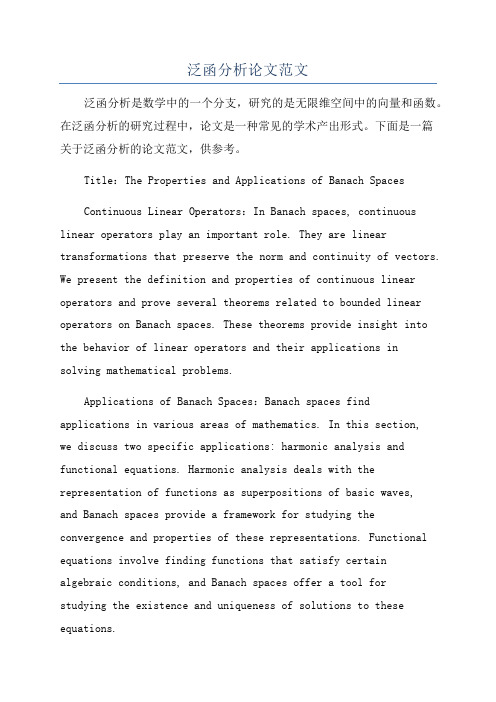
泛函分析论文范文泛函分析是数学中的一个分支,研究的是无限维空间中的向量和函数。
在泛函分析的研究过程中,论文是一种常见的学术产出形式。
下面是一篇关于泛函分析的论文范文,供参考。
Title:The Properties and Applications of Banach SpacesContinuous Linear Operators:In Banach spaces, continuous linear operators play an important role. They are linear transformations that preserve the norm and continuity of vectors. We present the definition and properties of continuous linear operators and prove several theorems related to bounded linear operators on Banach spaces. These theorems provide insight into the behavior of linear operators and their applications insolving mathematical problems.Applications of Banach Spaces:Banach spaces findapplications in various areas of mathematics. In this section,we discuss two specific applications: harmonic analysis and functional equations. Harmonic analysis deals with the representation of functions as superpositions of basic waves,and Banach spaces provide a framework for studying the convergence and properties of these representations. Functional equations involve finding functions that satisfy certainalgebraic conditions, and Banach spaces offer a tool forstudying the existence and uniqueness of solutions to these equations.。
泛函分析学习心得
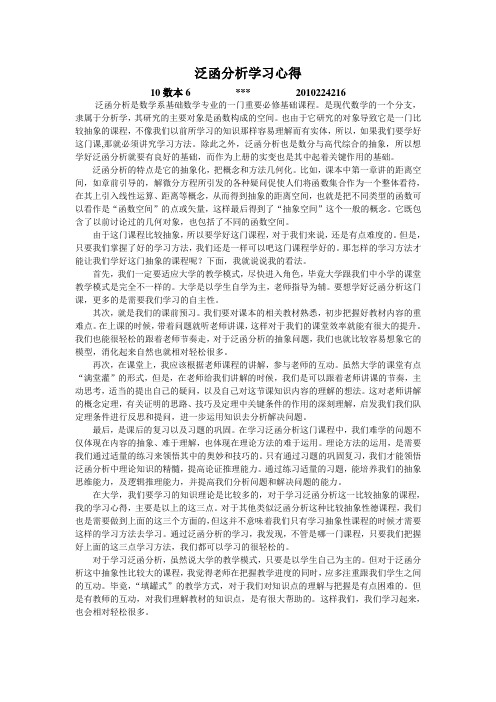
泛函分析学习心得10数本6 *** 2010224216泛函分析是数学系基础数学专业的一门重要必修基础课程。
是现代数学的一个分支,隶属于分析学,其研究的主要对象是函数构成的空间。
也由于它研究的对象导致它是一门比较抽象的课程,不像我们以前所学习的知识那样容易理解而有实体,所以,如果我们要学好这门课,那就必须讲究学习方法。
除此之外,泛函分析也是数分与高代综合的抽象,所以想学好泛函分析就要有良好的基础,而作为上册的实变也是其中起着关键作用的基础。
泛函分析的特点是它的抽象化,把概念和方法几何化。
比如,课本中第一章讲的距离空间,如章前引导的,解微分方程所引发的各种疑问促使人们将函数集合作为一个整体看待,在其上引入线性运算、距离等概念,从而得到抽象的距离空间,也就是把不同类型的函数可以看作是“函数空间”的点或矢量,这样最后得到了“抽象空间”这个一般的概念。
它既包含了以前讨论过的几何对象,也包括了不同的函数空间。
由于这门课程比较抽象,所以要学好这门课程,对于我们来说,还是有点难度的。
但是,只要我们掌握了好的学习方法,我们还是一样可以吧这门课程学好的。
那怎样的学习方法才能让我们学好这门抽象的课程呢?下面,我就说说我的看法。
首先,我们一定要适应大学的教学模式,尽快进入角色,毕竟大学跟我们中小学的课堂教学模式是完全不一样的。
大学是以学生自学为主,老师指导为辅。
要想学好泛函分析这门课,更多的是需要我们学习的自主性。
其次,就是我们的课前预习。
我们要对课本的相关教材熟悉,初步把握好教材内容的重难点。
在上课的时候,带着问题就听老师讲课,这样对于我们的课堂效率就能有很大的提升。
我们也能很轻松的跟着老师节奏走,对于泛函分析的抽象问题,我们也就比较容易想象它的模型,消化起来自然也就相对轻松很多。
再次,在课堂上,我应该根据老师课程的讲解,参与老师的互动。
虽然大学的课堂有点“满堂灌”的形式,但是,在老师给我们讲解的时候,我们是可以跟着老师讲课的节奏,主动思考,适当的提出自己的疑问,以及自己对这节课知识内容的理解的想法。
[数学]泛函分析
![[数学]泛函分析](https://img.taocdn.com/s3/m/ef398d2deff9aef8941e063c.png)
1.1.1 证明完备度量空间的闭子集是完备的子空间,而任一度量空间中的完备子空间必是闭子集.证明:(1) 设(X, ρ)是完备度量空间,A⊆X,A是X的闭子集.若{x n}是A中的Cauchy列,则{x n}也是X中的Cauchy列.因(X, ρ)完备,故{x n}收敛于X中某点x.而A是X的闭子集,且{x n}是A中的点列,故其极限x也在A中.因此,{x n}是子空间A中收敛列.所以,子空间(A, ρ)是完备的.(2) 设(X, ρ)是度量空间,B⊆X,B是X的完备子空间.若{x n}是B中的点列,且在X中收敛于x∈X.则{x n}是X中的Cauchy列,因此{x n}也是B中的Cauchy列.由B是X的完备子空间,故{x n}也是B中的收敛列.若{x n}在B中收敛于y∈B,则{x n}作为X中的点列也收敛于y.由极限的唯一性,x∈y.故x∈B.所以B是X中的闭子集.1.1.4 设T是度量空间上的压缩映射,求证T是连续的.证明:设(X, ρ)是度量空间,0 < α< 1,T : X→X是满足ρ(Tx, Ty) ≤α·ρ(x, y) (∀x, y∈X )的压缩映射.若{x n}是X中收敛于x的点列,则ρ(x n, x)→ 0.而ρ(Tx n, Tx) ≤α·ρ(x n, x),故有ρ(Tx n, Tx) → 0.因此T连续.1.1.5 设T是压缩映射,求证T n (n∈N+)也是压缩映射,并说明逆命题不一定成立.证明:(1) 设(X, ρ)是度量空间,0 < α< 1,T : X→X是满足ρ(Tx, Ty) ≤α·ρ(x, y) (∀x, y∈X )的压缩映射.∀n∈N+,若S = T n是压缩映射,则∀x, y∈X,有ρ(T n+1x, T n+1y) = ρ(T n(Tx), T n(Ty)) = ρ(S(Tx), S(Ty)) ≤ρ(Tx, Ty) ≤α·ρ(x, y).所以T n+1也是压缩映射.由数学归纳法原理,T n (n∈N+)都是压缩映射.(2) 逆命题不成立的例子:考虑T : [0, 2]→ [0, 2],其中T定义如下:当x∈[0, 1]时,T(x) = 0;当x∈(1, 2]时,T(x) = x - 1.显然T不是压缩映射.但∀x∈[0, 2],T(T(x)) = 0.因此,T2是压缩映射.1.1.6 设M是(P n, ρ)中的有界闭集,映射T : M→M满足:ρ(Tx, Ty) < ρ(x, y)(∀x, y∈M,x ≠y).求证T在M中存在唯一的不动点.证明:(反证法) 假若T在M中没有不动点.显然,T在M上是连续的,故函数ρ(x, Tx)在M上连续且恒大于0.因M是(P n, ρ)中的有界闭集,故ρ(x, Tx)在M中某点x0处达到下确界.0 < ρ(x0 , Tx0 ) ≤ρ(Tx0 , T2x0 ) < ρ(x0 , Tx0),矛盾.所以,T在M中存在不动点.根据1.1.3,该不动点是唯一的.1.1.7 对于积分方程x(t) -λ⎰[0, 1]e t–s x(s) ds = y(t),其中y(t)∈C[0, 1]为一给定函数,λ为常数.| λ| < 1,求证存在唯一解x(t)∈C[0, 1].证明:首先积分方程等价于e–t x(t) -λ⎰[0, 1]e–s x(s) ds = e–t y(t),令z(t) = e–t x(t),w(t) = e–t w(t),则方程变为z(t) -λ⎰[0, 1]z(s) ds = w(t).因此只要证明上面的方程有唯一解z(t)∈C[0, 1].设T : C[0, 1] →C[0, 1],(Tz)(t) = w(t) + λ⎰[0, 1]z(s) ds.则∀z1, z2∈C[0, 1],| (Tz1)(t) - (Tz2)(t) | = | λ| · | ⎰[0, 1] (z1(s) -z2(s)) ds |≤ | λ| ·⎰[0, 1] | z1(s) -z2(s) | ds ≤ | λ| · max t∈[0, 1] | z1(t) -z2(t) |;故ρ(Tz1, Tz2) ≤ | λ| ·ρ(z1, z2).因此,T是C[0, 1]上的压缩映射.故T在C[0, 1]上有唯一不动点.即存在唯一的z(t)∈C[0, 1],使得z(t) = w(t) + λ⎰[0, 1]z(s) ds.1.2.2 在一个度量空间(X, ρ)上,求证:基本列是收敛列,当且仅当其中存在一串收敛子列.证明:必要性是显然的,只证明充分性.设{x n}是X中的一个Cauchy列,且{x n}有一个收敛子列{x n(k)},记x n(k) →x.∀ε > 0,存在N∈N+,使得∀m, n≥N都有ρ(x n, x m) < ε /2.对此ε,存在K∈N+,使得∀k≥K都有ρ(x n(k), x) < ε /2.令L = max{K, N},则ρ(x n(L), x) < ε /2,且n(L) ≥L ≥N.当n≥N时,ρ(x n, x n(L)) < ε /2.故ρ(x n, x) ≤ρ(x n, x n(L)) + ρ(x n(L), x) < ε /2 + ε /2 = ε.所以,x n→x ( n→∞).因此{x n}是X中的收敛列.1.2.3 设F是只有有限项不为0的实数列全体,在F上引进距离ρ(x, y) = sup k ≥ 1 | ξk -ηk |,其中x = {ξk }∈F,y = {ηk }∈F.求证(F,ρ)不完备,并指出它的完备化空间.证明:(1) 首先,容易验证(F,ρ)是度量空间.∀n∈N+,令x n = {1, 1/2, 1/3, ..., 1/n, 0, 0, ...},则x n∈F.当m > n时,ρ(x n, x m) = sup k ≥ 1 | ξk(n)-ξk(m)|= max{1/(n + 1), 1/(n + 2), ..., 1/m}= 1/(n + 1) → 0 ( n→∞).故{x n}为F中的Cauchy列.下面证明{x n}不是F中的收敛列.若不然,设x n →x∈F.记x = ( ξ1, ξ2, ..., ξN, 0, 0, ... ).当n > N时,总有ρ(x n, x) ≥ | 1/(N + 1) – 0 | = 1/(N + 1),故ρ(x n, x)不收敛于0,这与前面的假设x n →x相矛盾.因此,{x n}不是F中的收敛列.这就说明了(F,ρ)不是完备的.(2) 从前述的{x n}的构造可以看出,我们可以任意选定一个收敛于0的实数列{u k},令y n = {u1, u2, ..., u n, 0, 0, ...},则{y n}必为F中的Cauchy列.我们设c0是收敛于0的实数列全体,在c0上引进距离ρ(x, y) = sup k ≥ 1 | ξk -ηk |,其中x = ( ξ1, ξ2, ..., ξk, ... )∈c0,y = ( η1, η2, ..., ηk, ... )∈c0.首先我们证明(c0,ρ)是度量空间.事实上,我们只需要证明三角不等式.设x = (ξk), y = (ηk ), y = (ζk )∈c0,则ρ(x, y) = sup k ≥ 1 | ξk -ηk | ≤ sup k ≥ 1 (| ξk -ζk | + | ζk -ηk | )≤ sup k ≥ 1 | ξk -ζk | + sup k ≥ 1 | ζk -ηk | = ρ(x, z) + ρ(z, y).所以,(c0,ρ)是度量空间.显然,(F,ρ)是(c0,ρ)的一个子空间.现在我们证明(c0,ρ)是完备度量空间.设{x n}是(c0,ρ)中的一个Cauchy列,记x n = ( ξ1(n), ξ2(n), ..., ξk(n), ... ).∀k∈N+,因为ρ(x n, x m) = sup k ≥ 1 | ξk(n)-ξk(m)| ≥ | ξk(n)-ξk(m)|,故{ξk(n)}n是P中的Cauchy列,故为收敛列.设ξk(n) →ξk ( n→∞).并设x = ( ξ1, ξ2, ..., ξk, ... ).下面证明x∈c0.∀ε > 0,存在N∈N+,使得∀m, n≥N,有ρ(x n, x m) < ε/2.特别地,ρ(x n, x N) < ε/2.因此,∀k∈N+,有| ξk(n)-ξk(N)| < ε/2.令n→∞,得| ξk -ξk(N)| ≤ε/2.而x N = (ξ1(N), ξ2(N), ..., ξk(N), ... )是一个收敛于0的数列.故存在K∈N+,使得∀k≥K,| ξk(N)| < ε/2.因此,| ξk | ≤ | ξk -ξk(N)| + | ξk(N)| < ε/2 + ε/2 = ε.即x = ( ξ1, ξ2, ..., ξk, ... )为一个收敛于0的数列,因此,x∈c0.下面证明{x n}是c0中收敛于x的点列.∀ε > 0,存在N∈N+,使得∀m, n≥N,有ρ(x n, x m) < ε.因此∀k∈N+,有| ξk(n)-ξk(m)| < ε.令m→∞,得| ξk(n)-ξk | ≤ε.所以,ρ(x n, x) ≤ε.这样就证明{x n}收敛于x.综上所述,我们可以把(F,ρ)嵌入到完备度量空间(c0,ρ)中.最后,我们只要再证明F是c0的稠密子集即可.事实上,对照(2)的开始部分,对于任意x = ( ξ1, ξ2, ..., ξk, ... )∈c0,令y n = {ξ1, ξ2, ..., ξn, 0, 0, ...},则{y n}是F中的点列,而且是c0中的Cauchy列.根据c0的完备性的证明,我们知道,{y n}必然收敛于x = ( ξ1, ξ2, ..., ξk, ... ).所以F在(c0,ρ)中稠密.根据教材p11命题1.2.5,(c0,ρ)是(F,ρ)的完备化.1.2.4 求证:[0, 1]上的多项式全体按照距离ρ1( p, q ) = ⎰[0, 1] | p(x) -q(x) | dx ( p, q是多项式)是不完备的,并指出它的完备化空间.证明:记[0, 1]上的多项式全体为P,连续函数全体为C,Lebesgue可积函数全体为L1,则有P⊆C⊆L1.记C上的度量为ρ( f, g ) = max x∈[0, 1] | f(x) -g(x) |.(1) 令f n(x) = arctan( x- 1/2 ),h(x) = (π/2) sign( x- 1/2 ),x∈[0, 1].则f n∈C,且{ f n}在(L1, ρ1)中收敛于h,因此{ f n}是(L1, ρ1)中的基本列.根据数学分析中的Weierstrass定理,P在(C, ρ)中稠密.故∀n∈N+,存在p n∈P,使得ρ( p n, f n) < 1/n.因此ρ1( p n, f n) = ⎰[0, 1] | p n(x) -f n(x) | dx ≤ρ( p n, f n) < 1/n.所以,ρ1( p n, h) ≤ρ1( p n, f n) + ρ1( f n, h) → 0 ( n→∞).这说明{ p n}是(L1, ρ1)中的收敛列,从而{ p n}是(L1, ρ1)中的基本列.因此{ p n}也是(P, ρ1)中的基本列.假如{ p n}在(P, ρ1)中收敛于g∈P,则{ p n}在(L1, ρ1)中也收敛于g∈P.故g和h是(L1, ρ1)中的同一点(几乎处处相等).显然,h不能与连续函数几乎处处相等,故h∉C,因此h∉P.从而g∉P.矛盾.这样我们就找到了(P, ρ1)中的基本列,而它不是(P, ρ1)中的收敛列.所以(P, ρ1)不完备.(2) 根据实分析中的结论,C在(L1, ρ1)中稠密.设ϕ∈L1.则∀ε > 0,存在f∈C,使得ρ1( f, ϕ) < ε/2.而P在(C, ρ)中稠密,故存在p∈P,使得ρ( p, f ) < ε/2.ρ1( p, f) = ⎰[0, 1] | p(x) -f(x) | dx ≤ρ( p, f ) < ε/2.所以,ρ1( p, ϕ) ≤ρ1( p, f ) +ρ1( f, ϕ) < ε.因此P在(L1, ρ1)中稠密.根据教材p11命题1.2.5以及(L1, ρ1)的完备性得知(L1, ρ1)是(P, ρ1)的完备化.1.2.5 在完备度量空间(X, ρ)中给定点列{x n},如果∀ε > 0,存在基本列{y n},使得ρ( x n, y n) < ε (n∈N+).求证{x n}收敛.证明:只要证明{x n}也是基本列即可.事实上,∀ε > 0,存在基本列{y n},使得ρ( x n, y n) < ε/3 (n∈N+).存在N∈N+,使得∀m, n≥N,有ρ(y n, y m) < ε/3.此时,ρ( x n, x m) ≤ρ(x n, y n) + ρ(y n, y m) + ρ(y m, x m) < ε.故{x n}是基本列,所以{x n}收敛.1.3.2 在度量空间中,求证:紧集上的连续函数必是有界的,并且能达到它的上、下确界.证明:设(X, ρ)是度量空间,D是紧子集,f : D→P是连续函数.(1) 若f无上界,则∀n∈N+,存在x n∈D,使得f (x n) > 1/n.因D是紧集,故D是自列紧的.所以{x n}存在收敛子列x n(k) →x0∈D (k→∞).由f的连续性,f (x n(k))→f (x0) (k→∞).但由f (x n) > 1/n知f (x n)→ +∞(n→∞),所以f (x n(k))→ +∞ (k→∞),矛盾.故f有上界.同理,故f有下界.(2) 设M = sup x∈D f(x),则∀n∈N+,存在y n∈D,使得f (y n) > M- 1/n.{y n}存在子列y n(k) →y0∈D (k→∞).因此f ( y0 ) ≥M.而根据M的定义,又有f ( y0 ) ≤M.所以f ( y0 ) = M.因此f能达到它的上确界.同理,f能达到它的下确界.1.3.3 在度量空间中,求证:完全有界的集合是有界的,并通过考虑l 2的子集E= {e k }k≥e k = { 0, 0, ..., 1, 0, ... } (只是第k个坐标为1,其余都是0 ),来说明一1,其中个集合可以是有界的但不完全有界的.证明:(1) 若A是度量空间(X, ρ)中的完全有界集.则存在A的有限1-网N = { x0, x1, x2, ..., x n }.令R = ∑1 ≤j≤nρ(x0, x j) + 1.则∀x∈A,存在某个j使得 0 ≤j≤n,且ρ(x, x j) < 1.因此,ρ(x, x0) ≤ρ(x, x j) + ρ(x j, x0) ≤ 1 + ∑1 ≤j≤nρ(x0, x j) = R.所以A是度量空间(X, ρ)中的有界集.(2) 注意到ρ(e k , e j) = 21/2 ( ∀k ≠ j ),故E中任意点列都不是Cauchy列.所以,E中任意点列都没有收敛子列(否则,该收敛子列就是Cauchy列,矛盾).因此,E不是列紧集.由l 2是完备的,以及Hausdorff定理,知E不是全有界集.但E显然是有界集.1.3.4 设(X, ρ)是度量空间,F1, F2是它的两个紧子集,求证:∃x i ∈F i( i = 1, 2),使得ρ(F1, F2) = ρ(x1, x2).其中ρ(F1, F2) = inf {ρ(x, y) | x∈F1, y∈F2 }证明:由ρ(F1, F2)的定义,∀n∈N+,∃x i(n)∈F i( i = 1, 2),使得ρ(x1(n), x2(n)) < ρ(F1, F2) + 1/n.因F1, F2紧,故不妨假设{x1(n)}, {x2(n)}都是收敛列.设它们的极限分别为x1, x2,则ρ(x1, x2) ≤ρ(F1, F2).因此ρ(F1, F2) = ρ(x1, x2).1.3.5 设M是C[a, b]中的有界集,求证集合{F(x) =⎰[a, x]f(t) dt | f∈M }是列紧集.证明:设A = {F(x) =⎰[a, x]f(t) dt | f∈M }.由M有界,故存在K > 0,使得∀f∈M,ρ( f, 0) ≤K.先证明A是一致有界的和等度连续的.∀F∈A,存在f∈M,使得F(x) =⎰[a, x]f(t) dt.由于ρ(F, 0) = max x∈[a, b] | F(x) | = max x∈[a, b] | ⎰[a, x]f(t) dt |≤ max x∈[a, b] | f(t) | · (b -a ) = ρ( f, 0) · (b -a ) ≤K (b -a ).故A是一致有界的.∀ε > 0,∀s, t∈[a, b],当| s-t| < ε/K时,∀F∈A,存在f∈M,使得F(x) =⎰[a, x]f(u) du.| F(s) -F(t) | = | ⎰[s, t]f(u) du | ≤ max u∈[a, b] | f(u) | · | s -t |= ρ( f, 0) · | s -t | ≤K· (ε/K) = ε.故A是等度连续的.由Arzela-Ascoli定理,A是列紧集.1.3.6 设E = {sin nt}n≥ 1,求证:E在C[0, π]中不是列紧的.证明:显然E是一致有界的.根据Arzela-Ascoli定理,我们只要证明E不是等度连续的即可.我们的想法是找一个E中的点列f n,以及[0, π]中的两个点列s n和t n,使得| s n -t n | → 0,但| f n(s n)-f n(t n)|不收敛于0.事实上,这是可以做到的,只要令f n (u) = sin (2n u),s n = (π/2)(1 + 1/(2n)),t n = (π/2)(1 - 1/(2n)).则s n + t n = π;s n -t n = π/(2n)→ 0 (n→∞).因此,| f n(s n)-f n(t n)| = 2 | sin (2n s n) - sin (2n t n) |= 2 | sin (n (s n -t n)) cos (n (s n + t n)) |= 2 | sin (π/2) cos (n π) | = 2.所以,E不是等度连续的.进而,E在C[0, π]中不是列紧的..3.7 求证S空间的子集A是列紧的充要条件是:∀n∈N+,∃C n> 0,使得∀x = (ξ1, ξ2, ..., ξn, ...)∈A,都有| ξn | ≤C n ( n = 1, 2, ...).证明:(⇐) 设x k = (ξ1(k), ξ2(k), ..., ξn(k), ...) ( k = 1, 2, ... )是A中的点列.存在{x k}的子列{x1, k}使得其第1个坐标ξ1(1, k)收敛;存在{x1, k}的子列{x2, k}使得其第2个坐标ξ2(2, k)收敛;如此下去,得到一个{x k}的子列的序列,第( j +1)个子列是第j个子列的子列,且第j个子列的第j个坐标是收敛的.选取对角线构成的点列{x j, j},则{x j, j}是{x k}的子列,且每个坐标都收敛.根据习题1.2.1的证明可知,S空间的点列收敛的充要条件是坐标收敛.故{x j, j}是收敛点列.所以,A是列紧的.(⇒) 我们只要证明,∀n∈N+,A中的点的第n个坐标所构成的集合是有界集.若不然,设A中的点的第N个坐标所构成的集合是无界的.则存在A中的点列x k = (ξ1(k), ξ2(k), ..., ξn(k), ...) ( k = 1, 2, ... ),使得| ξN(k) | > k.显然,{ ξN(k) }无收敛子列,故{ x k }也无收敛子列,这与A列紧相矛盾.这样就完成了必要性的证明.1.3.8 设(X, ρ)是度量空间,M是X中的列紧集,映射f : X →M满足ρ( f (x1), f (x2)) < ρ( x1, x2 ) (∀x1, x2∈M, x1≠x2).求证:f在X中存在唯一的不动点.证明:(1) 首先证明cl(M)是紧集.为此只要证明cl(M)列紧即可.设{ x n }是cl(M)中的点列,则存在M中的点列{ y n }使得ρ( x n, y n) < 1/n.因M列紧,故{ y n }有收敛子列{ y n(k)},设y n(k) →u∈cl(M).显然{ x n(k)}也是收敛的,并且也收敛于u∈cl(M).所以cl(M)是自列紧的,因而是紧集.(2) 令g(x) = ρ( x, f (x)),则g是X上的连续函数.事实上,由ρ( f (x1), f (x2)) < ρ( x1, x2 )可知f : X →M是连续的,因而g也连续.由习题1.3.2知存在x0∈cl(M),使得g(x0) = inf {ρ( x, f (x)) | x∈cl(M) }.(3) 若g(x0) > 0,则ρ( x0, f (x0)) > 0,即x0≠f (x0).故ρ( x0, f (x0)) = g(x0) ≤g( f (x0)) = ρ( f (x0), f ( f (x0))) < ρ( x0, f (x0)),矛盾.所以,必有g(x0) = 0,即ρ( x0, f (x0)) = 0,因此x0就是f的不动点.1.3.9 设(M, ρ)是一个紧距离空间,又E⊆C(M),E中的函数一致有界并且满足下列的Hölder 条件:| x(t1) -x(t2) | ≤Cρ(t1, t2)α(∀x∈E,∀t1, t2∈M ),其中0 < α≤ 1,C > 0.求证:E在C(M)中是列紧集.证明:由Hölder条件易知E是等度连续的.又E中的函数一致有界,由Arzela-Ascoli定理知E是C(M)中的列紧集.1.4.2 设c[0, 1]表示(0, 1]上连续且有界的函数x(t)全体.∀x∈c[0, 1],令|| x || = sup{| x(t) | | 0 < t≤ 1}.求证:(1) || ·||是c[0, 1]空间上的范数.(2) l∞与c[0, 1]的一个子空间是等距同构的.证明:(1) 正定性和齐次性都是明显的,我们只证明三角不等式.|| x || = sup{| x(t) | | 0 < t≤ 1}.|| x || + || y || = sup{| x(t) | | 0 < t≤ 1} + sup{| y(t) | | 0 < t≤ 1}≥ sup{| x(t) + y(t) | 0 < t≤ 1} = || x + y ||.所以|| ·||是c[0, 1]空间上的范数.(2) 任意取定(0, 1]中的一个单调递减列{a k },满足(i) a1 = 1;(ii) lim k→∞a k = 0.显然,在每个[a k + 1, a k]上为线性函数的f∈c[0, 1]是存在的.设X = { f∈c[0, 1] | f在每个[a k + 1, a k]上为线性函数 }.容易验证X是c[0, 1]的子空间.定义ϕ : X →l∞,f #ϕ ( f ) = ( f (a1), f (a2), ...).则ϕ : X →l∞是线性双射,且|| ϕ ( f ) ||∞= sup k ≥ 1 | f (a k) | = sup0 < t≤ 1 { | f (t ) | } = || f ||.所以,ϕ : X →l∞是等距同构.因此,l∞与c[0, 1]的一个子空间是等距同构的.1.4.3 在C1[a, b]中,令|| f ||1 = (⎰[a, b] ( | f(x) |2 + | f’(x) |2) dx )1/2 (∀f∈C1[a,b]).(1) 求证:|| · ||1是C1[a, b]上的范数.(2) 问(C1[a, b], || · ||1)是否完备?证明:(1) 正定性和齐次性都是明显的,和前面的习题一样,只验证三角不等式.我们先来证明一个比较一般的结果:若线性空间X上的非负实值函数p, q都满足三角不等式:p(x) + p(y) ≥p(x +y),q(x) + q(y) ≥q(x +y),∀x, y∈X;则函数h = ( p2 + q2 )1/2也满足三角不等式.事实上,∀x, y∈X,由Minkowski不等式,我们有h(x) + h(y) = ( p(x)2 + q(x)2 )1/2 + ( p(y)2 + q(y)2 )1/2≥ (( p(x)+ p(y))2 + ( q(x) + q(y))2 )1/2 ≥ ( p(x + y)2 + q(x + y)2 )1/2 = h(x + y).回到本题:若令p( f ) = (⎰[a, b] | f(x) |2dx )1/2,q( f ) = (⎰[a, b] | f’(x) |2dx )1/2,则( p( f ) + p( g ))2 = ((⎰[a, b] | f(x) |2dx )1/2 + (⎰[a, b] | g(x) |2dx )1/2)2= ⎰[a, b] | f(x) |2dx + 2(⎰[a, b] | f(x) |2dx )1/2 · (⎰[a, b] | g(x)|2dx )1/2 + ⎰[a, b] | g(x) |2 dx≥⎰[a, b] | f(x)|2dx + 2 ⎰[a, b] | f(x) | · | g(x)| dx + ⎰[a, b] | g(x)|2dx= ⎰[a, b] ( | f(x) | + | g(x)| )2dx ≥⎰[a, b] ( | f(x) + g(x)| )2dx = ( p( f + g ))2.所以有p( f ) + p( g ) ≥p( f + g ).特别地,p( f’) + p( g’) ≥p( f’+ g’),即q( f ) + q( g ) ≥q( f + g ).因此,线性空间C1[a, b]上的非负实值函数p, q都满足三角不等式.根据开始证明的结论,|| · ||1也满足三角不等式.所以,|| · ||1是C1[a, b]上的范数.(2) 在C1[- 1, 1]中,令f n(x) = (x2 + 1/n2 )1/2 ( ∀x∈[- 1, 1] ).则f’n(x) = 2x (x2 + 1/n2 )-1/2 ( ∀x∈[- 1, 1] ).显然,f n(x)几乎处处收敛于| x |,f’n(x)几乎处处收敛于2sign( x ).因此,f n(x)依测度收敛于| x |,f’n(x)依测度收敛于2sign( x ).则f’n(x) = 2x (x2 + 1/n2 )-1/2 ( ∀x∈[- 1, 1] ).显然,f n(x)几乎处处收敛于| x |,f’n(x)几乎处处收敛于2sign( x ).因此,f n(x)依测度收敛于| x |,f’n(x)依测度收敛于2sign( x ).故在L2[- 1, 1]中,f n(x) → | x |,f’n(x) → 2sign( x ).因此,它们都是L2[- 1, 1]中的基本列,故⎰[- 1, 1] | f n(x) -f m(x) |2 dx → 0 (m, n→∞);⎰[- 1, 1] | f’n(x) -f m’(x) |2 dx → 0 (m, n→∞).故|| f n-f m ||1 = (⎰[- 1, 1] ( | f n(x) -f m(x) |2 + | f’n(x) -f m’(x) |2 ) dx )1/2→ 0 (m, n→∞).即{ f n }是C1[- 1, 1]中的基本列.下面我们证明{ f n }不是C1[- 1, 1]中的收敛列.若不然,设{ f n }在C1[- 1, 1]中的收敛于f∈C1[- 1, 1].因|| f n-f ||1 = (⎰[- 1, 1] ( | f n(x) -f(x) |2 + | f’n(x) -f’(x) |2 ) dx )1/2≥ (⎰[- 1, 1] | f n(x) -f(x) |2dx )1/2,故在L2[- 1, 1]中,f n(x) →f.而在前面已说明L2[- 1, 1]中,f n(x) → | x |;由L2[- 1, 1]中极限的唯一性以及f的连续性,知f(x) = | x |.这样就得到f∉C1[- 1, 1],矛盾.所以,{ f n }不是C1[- 1, 1]中的收敛列.这说明C1[- 1, 1]不是完备的.对一般的C1[a, b],只要令f n(x) = (x - (a + b )/2)2 + 1/n2 )1/2 ( ∀x∈[a, b] )就可以做同样的讨论,就可以证明C1[a, b]不是完备空间.1.4.4 在C[0, 1]中,对每个f∈C[0, 1],令|| f ||1 = (⎰[0, 1] | f(x) |2dx )1/2,|| f ||2 = (⎰[0, 1] ( 1 + x) | f(x) |2dx )1/2.求证:|| · ||1和|| · ||2是C[0, 1]中的两个等价范数.证明:(1) 在习题1.4.3的证明中已经包含了|| · ||1是C[0, 1]中的范数的证明.下面我们证明|| · ||2是C[0, 1]中的范数,我们仍然只要验证三角不等式.|| f ||2 + || g ||2 = (⎰[0, 1] ( 1 + x) | f(x) |2dx )1/2 + (⎰[0, 1] ( 1 + x) | g(x) |2dx )1/2 = || (1 + x)1/2f(x) ||1 + || (1 + x)1/2g(x) ||1≥ || (1 + x)1/2f(x) + (1 + x)1/2g(x) ||1= || (1 + x)1/2 ( f(x) + g(x) ) ||1≥ (⎰[0, 1] (1 + x) | f(x) + g(x) |2dx )1/2 = || f + g ||2.所以,|| · ||2也是C[0, 1]中的范数.(2) 我们来证明两个范数的等价性.∀f∈C[0, 1]|| f ||1 = (⎰[0, 1] | f(x) |2dx )1/2 ≤ (⎰[0, 1] ( 1 + x) | f(x) |2dx )1/2 = || f ||2,|| f ||2 = (⎰[0, 1] ( 1 + x) | f(x) |2dx )1/2 ≤ 2 (⎰[0, 1] | f(x) |2dx )1/2 = 2 || f ||1.因此两个范数等价.1.4.10 求证范数的严格凸性等价于下列条件:|| x + y || = || x || + || y || ( ∀x≠θ, y≠θ) ⇒x = c y ( c > 0).证明:(⇒) 设范数是严格凸的,若x, y ≠θ满足|| x + y || = || x || + || y ||,事实上,我们总有|| (x/|| x ||) || = || (y/|| y ||) || = 1.因x, y ≠θ,故|| x || + || y || > 0,所以|| x + y || ≠ 0.于是|| x ||/|| x + y || + || y ||/|| x + y || = 1.假若x/|| x || ≠y/|| y ||,由严格凸性,得到|| (|| x ||/|| x + y ||)(x/|| x ||) + (|| y ||/|| x + y ||)(y/|| y ||) || < 1,即|| (( x + y )/|| x + y ||) || < 1,矛盾.因此必然有x/|| x || = y/|| y ||,即x = (|| x ||/|| y ||) y.(⇐) 设∀x, y ≠θ,|| x + y || = || x || + || y ||蕴涵x = c y ( c > 0).下面证明范数是严格凸的.设x≠y,且|| x || = || y || = 1,又设α, β∈(0, 1),且α + β= 1.我们知道|| α x + β y || ≤ || α x || + || β y || = α || x || + β|| y || = α + β= 1.假若|| α x + β y || = 1,根据我们的条件,就得到α x = c (β y),其中c > 0.那么,就有|| α x || = || c (β y) ||,而|| x || = || y || = 1,所以α= c β;故x = y,这就与x≠y相矛盾.所以必然有|| α x + β y || < 1,即范数是严格凸的.1.4.11 设X是线性赋范空间,函数ϕ : X →P1称为凸的,如果不等式ϕ( λ x + (1 -λ) y ) ≤λϕ( x ) + (1 -λ)ϕ( y ) ( ∀ 0 ≤λ≤ 1) 成立.求证凸函数的局部极小值必然是全空间的最小值.证明:设x0是凸函数ϕ的一个局部极小点.如果存在x∈X,使得ϕ( x ) < ϕ( x0),则∀ t ∈(0, 1),ϕ( t x + (1 -t ) x0) ≤t ϕ( x ) + (1 -t )ϕ( x0) < t ϕ( x0) + (1 -t )ϕ( x0) = ϕ( x0).而对x0的任意邻域U,都存在t ∈(0, 1),使得t x + (1 -t ) x0∈U.这就与x0是局部极小点相矛盾.因此∀x∈X,都有ϕ( x0) ≤ϕ( x ),即x0是ϕ的最小点.1.4.12 设(X, || · ||)是一线性赋范空间,M是X的有限维子空间,{e1, e2, ..., e n}是M的一组基,给定g∈X,引进函数F : K n →K1.对∀c = (c1, c2, ..., c n)∈K n,规定F(c) = F(c1, c2, ..., c n) = || ∑1 ≤i≤n c i e i-g ||.(1) 求证F是一个凸函数;(2) 若F的最小值点是c = (c1, c2, ..., c n),求证f = ∑1 ≤i≤n c i e i给出g在M中的最佳逼近元.证明:(1) 设c = (c1, c2, ..., c n), d = (d1, d2, ..., d n)∈K n, λ∈[0, 1],则F(λ c + ( 1 -λ) d ) = || ∑1 ≤i≤n ( λ c i + ( 1 -λ) d i ) e i-g ||= || λ∑1 ≤i≤n c i e i + ( 1 -λ) ∑1 ≤i≤n d i e i- (λ g+ ( 1 -λ)g )||= || λ(∑1 ≤i≤n c i e i -g) + ( 1 -λ) ( ∑1 ≤i≤n d i e i-g )||≤λ|| ∑1 ≤i≤n c i e i -g || + ( 1 -λ) || ∑1 ≤i≤n d i e i-g ||= λ F(c)+ ( 1 -λ)F(d),故F是一个凸函数.(2) 因为{e1, e2, ..., e n}是M的一组基,故M中的每个元h都可表示为h = ∑1 ≤i≤n d i e i,其中d = (d1, d2, ..., d n)∈K n.因为F(c) ≤F(d),故|| f-g || = F(c) ≤F(d) = || h-g ||.那么f就是g在M中的最佳逼近元.1.4.15 设X是B*空间,M是X的有限维真子空间,求证:∃y∈X,|| y|| = 1,使得|| y–x || ≥ 1 ( ∀x ∈M ).证明:取定z∈X \ M,令Y = span{z} + M.记S = { y∈Y | || y || = 1 }.则M是Y的真闭子空间,而S是Y中的单位球面.由Riesz引理,∀n∈N+,存在y n∈S,使得d( y n, M ) ≥ 1 - 1/n.因为Y也是有限维的,故其中的单位球面为自列紧集.存在{y n}的收敛子列.不妨设y n(k) →y∈S.则d( y n(k), M ) ≥ 1 - 1/n(k),故有d( y, M ) ≥ 1.即|| y–x || ≥ 1 ( ∀x ∈M ).1.4.17 (商空间) 设X是线性赋范空间,X0是X的闭线性子空间,将X中的向量分类,凡是适合x’-x’’∈X0的两个向量x’, x’’归于同一类,称其为等价类,把一个等价类看成一个新的向量,这种向量的全体组成的集合为X/X0表示,并称其为商空间.下列是关于商空间的命题.(1) 设[ y ]∈X/X0,x∈X,求证:x∈[ y ]的充分必要条件是[ y ] = x + X0.证明:设x’, x’’∈X,若它们归于同一类,则记为x’~x’’.我们用[ x ]表示x所在的等价类(大家注意,题目形式已经作了相应的修改).(⇒) 若x∈[ y ],则x~y.∀u ∈[ y ],u~y,故u~x,即u –x∈X0.因此u ∈x + X0.所以[ y ] ⊆x + X0.反过来,∀u ∈x + X0,则u~x,故u~y.因此u ∈[ y ].所以x + X0 ⊆ [ y ].所以[ y ] = x + X0.(⇐) 若[ y ] = x + X0,则y –x∈X0,即y~x.从而x∈[ y ].(2) 在X/X0中定义加法与数乘如下:[ x ] + [ y ] = x + y + X0(∀[ x ], [ y ] ∈X/X0 )λ[ x ] = λ x + X0(∀[ x ]∈X/X0 , ∀λ∈K )其中x和y分别表示属于等价类[ x ]和[ y ]的任一元素.又规定范数|| [ x ] ||0 = inf z∈[ x ] || z || ( ∀[ x ]∈X/X0 )求证:(X/X0, || · ||0)是一个B*空间.证明:第(1)部分说明了[ x ] = x + X0.容易看出加法与乘法的定义是合理的.进一步可以证明X/X0 构成数域K上的线性空间,且其零元为[ θ] = X0.下面证明|| · ||0是X/X0 上的范数.显然,∀[ x ]∈X/X0,|| [ x ] ||0≥ 0.若[ x ] = [ θ] = X0,则|| [ x ] ||0 = 0.若|| [ x ] ||0 = 0,则inf z∈[ x ] || z || = 0.存在z n∈[ x ]使得|| z n || → 0,即z n→θ (n→∞).那么,x-z n∈X0,x-z n→x (n→∞),而X0是闭集,故x∈X0.所以x~θ,即[ x ] = X0.因此|| · ||0有正定性.∀[ x ]∈X/X0,∀λ∈K,|| λ[ x ]||0 = || [ λ x ] ||0 = inf y∈[ x ] || λ y || = inf y∈[ x ] | λ| · || y || = | λ| · inf y∈[ x ] || y || = | λ| · ||[ x ]||0.因此|| · ||0有齐次性.∀[ x ], [ y ]∈X/X0,|| [ x ] + [ y ] ||0 = inf z∈[ x ] + [ y ] || z || = inf u∈[ x ], v∈[ y ] || u + v ||≤ inf u∈[ x ], v∈[ y ] { || u || + || v || } ≤ inf u∈[ x ] { inf v∈[ y ] { || u || + || v ||} } ≤ inf u∈[ x ] { inf v∈[ y ] { || u || + || v ||} } = inf u∈[ x ] { || u || + inf v∈[ y ] || v || } = inf u∈[ x ] || u || + inf v∈[ y ] || v || = || [ x ] ||0 + || [ y ] ||0.因此|| · ||0的三角不等式成立.所以,(X/X0, || · ||0)是一个B*空间.(3) 设[ x ]∈X/X0, 求证对∀y∈[ x ]有inf { || y -z || | z∈X0 } = || [ x ] ||0.证明:|| [ x ] ||0 = inf u∈[ x ] || u || = inf u∈[ y ] || u || = inf { || u || | u∈y + X0 }= inf { || y + v || | v∈X0 } = inf { || y -z || | z∈X0 }.(4) 定义映射ϕ : X →X/X0为ϕ (x) = [ x ] = x + X0 (∀x∈X ).求证ϕ是线性连续映射.证明:∀x, y∈X,∀α, β∈K,ϕ( α x + β y ) = [α x + β y ] = [α x ] + [ β y ] = α [ x ] + β[ y ] = αϕ (x) + βϕ (y).|| ϕ (x) -ϕ (y) ||0 = || [ x ] - [ y ] ||0 = || [ x-y ] ||0 = inf z∈[ x-y ] || z || ≤ || x-y ||.所以,ϕ是线性连续映射.(5) ∀[ x ]∈X/X0,求证∃y∈X,使得ϕ (y) = [ x ],且|| y || ≤ 2|| [ x ] ||0.证明:因为|| [ x ] ||0 = inf z∈[ x ] || z ||,若|| [ x ] ||0 = 0,则由|| · ||0的正定性,知[ x ] = X0,取y = θ即满足要求.若|| [ x ] ||0≠ 0,则inf z∈[ x ] || z || = || [ x ] ||0 < 2 || [ x ] ||0,存在∃y∈[ x ],使得|| y || ≤ 2|| [ x ] ||0.此时显然有ϕ (y) = [ x ] = [ y ].(6) 设(X, || · ||)完备,求证(X/X0, || · ||0)也是完备的.证明:设{ [ x ]n }是X/X0中的基本列.为证明它是收敛列,只需证明它存在收敛子列.由基本列性质,可选出子列{ [ x ]n(k)}使得|| [ x ]n(k) - [ x ]n(k+1) ||0 ≤ 1/2k.故∑k ≥ 1 || [ x ]n(k) - [ x ]n(k+1) ||0 收敛.根据(5),∀k∈N+,∃y k∈[ x ]n(k+1) - [ x ]n(k),使得|| y k || ≤ 2|| [ x ]n(k+1) - [ x ]n(k) ||0.那么,∑k ≥ 1|| y k ||收敛.由X的完备性,s k = ∑ 1 ≤j ≤k y j是X中的收敛列.设其极限为s.由(5)中ϕ的连续性,在X/X0中,ϕ(s k) →ϕ(s) ( k→∞ ).而ϕ(s k) = ϕ( ∑ 1 ≤j ≤k y j ) = ∑ 1 ≤j ≤k ϕ( y j )= ∑ 1 ≤j ≤k ( [ x ]n(j+1) - [ x ]n(j)) = [ x ]n(k+1) - [ x ]n(1).故{[ x ]n(k+1) - [ x ]n(1)}收敛,因而{[ x ]n(k)}是收敛列.因此X/X0中的基本列{ [ x ]n }存在收敛子列{[ x ]n(k)},所以,{ [ x ]n }是X/X0中的收敛列.因此,(X/X0, || · ||0)是完备的.(7) 设X = C[0, 1],X0 = { f∈X | f (0) = 0 },求证:X/X0 ≅K,其中记号“≅”表示等距同构.证明:显然,X0是C[0, 1]中的线性子空间.记X0所确定的等价关系为~,则f~g ⇔ f (0) = g (0).定义Φ : X/X0 →K,Φ([ f ]) = f (0).显然定义是合理的.∀f, g∈X,∀α, β∈K,Φ(α[ f ] + β[ g ]) = Φ([αf + β g ]) = (αf + β g )(0)= αf (0)+ β g (0) = αΦ([ f ])+ βΦ([ g ]).因此Φ是线性映射.因Φ(X0) = 0,故Φ是单射.而∀c∈K,若记所对应的常值函数为h c∈C[0, 1],则Φ( [ h c] ) = c.故Φ是满射.综上所述,Φ : X/X0 →K是线性同构.∀f∈X,|| [ f ]||0 = inf g∈[ f ] { || g || } ≥ inf g∈[ f ] { | g (0) | }= inf g∈[ f ] { | f (0) | } = | f (0) | = | Φ([ f ]) |.另一方面,因为常值函数h f (0)∈[ f ],故|| [ f ]||0 = inf g∈[ f ] { || g || } ≤ || h f (0) || = | f (0) | = | Φ([ f ]) |.所以,∀f∈X,都有|| [ f ]||0 = | Φ([ f ]) |,因此Φ : X/X0 →K是等距同构.1.5.1 设X是B*空间,E是以θ为内点的真凸子集,P是由E产生的Minkowski泛函,求证:(1) x∈int(E) ⇔P(x) < 1;(2) cl(int(E)) = cl(E).证明:(1) (⇒) 若x∈int(E),存在δ > 0,使得Bδ(x) ⊆E.注意到x + x/n→x ( n→∞ ),故存在N ∈N+,使得x + x/N ∈Bδ(x) ⊆E.即x/( N/( 1 + N ) ) ∈E.因此P(x) ≤N/( 1 + N ) < 1.(⇐) 若P(x) < 1.则存在a > 1,使得y = a x∈E.因θ∈int(E),故存在δ > 0,使得Bδ(θ) ⊆E.令η = δ(a - 1)/a,∀z∈Bη(x),令w = (a z-y )/(a - 1),则|| w || = || (a z-y )/(a - 1) || = || a z-y ||/(a - 1)= || a z-a x ||/(a - 1) = a || z-x ||/(a - 1) < aη/(a - 1) = δ.故w∈Bδ(θ) ⊆E.故z = ((a - 1)w + y )/a ∈E,因此,Bη(x) ⊆E.所以x∈int(E).(2) 因int(E) = E,故有cl(int(E)) ⊆ cl(E).下面证明相反的包含关系.若x∈cl(E),则∀ε > 0,存在y∈E,使得|| x -y || < ε/2.因ny/(n + 1) →y ( n →∞ ).故存在N ∈N+,使得|| Ny/(N + 1) -y || < ε/2.令z = Ny/(N + 1),则z∈E,且P(z) ≤N/(N + 1) < 1,由(1)知z∈int(E).而|| z -x || ≤ || z -y || + || y -x || < ε/2 + ε/2 = ε.故x∈cl(int(E)),因此cl(E) ⊆ cl(int(E))所以cl(int(E)) = cl(E).1.5.2 求证在B空间中,列紧集的凸包是列紧集.证明:设A是B空间X中的列紧集,∀ε > 0,存在A的有限ε /3网B.设B = {b1, b2, ..., b n},M = max j{ || b j || },取δ > 0,使得n δ M < ε /3.设[0, 1]分划D为0 = t0 < t1 < t2 < ... < t m = 1,使得max 1 ≤j ≤m {| t j–t j–1|} < δ.设∀x∈co(A),设x= λ1 a1 + λ2 a2+ ... + λ k a k,其中a j∈A,λ j > 0,∑ j λ j = 1.对每个j ≤k,存在b i( j )∈B使得|| a j-b i( j ) || < ε /3;令y= λ1 b i(1) + λ2 b i(2)+ ... + λ k b i(k),则|| x - y || = || λ1 (a1 -b i(1)) + λ2 (a2 -b i(2))+ ... + λ k (a k-b i(k))||,≤λ1· || a1 -b i(1) || + λ2 · || a2 -b i(2) || + ... + λ k· || a k-b i(k) ||≤ ( λ1 + λ2 + ... + λ k ) · (ε /2) = ε /3.将y= λ1 b i(1) + λ2 b i(2)+ ... + λ k b i(k)中的那些含有相同b j的项合并起来,于是,y可表示为y= μ1 b1 + μ2 b2+ ... + μ n b n,其中μj ≥ 0,且∑ j μj = 1.对每个l ≤n,存在t s( l )∈D,使得|| μl-t s( l ) || < δ;令z= t s(1) b1 + t s(2) b2+ ... + t s(n) b n,则|| y - z || = || (μ1 -t s(1))b1 + (μ2 -t s(2))b2+ ... + (μn -t s(n))b n ||≤∑ l | μl-t s( l ) | · max j{ || b j || } ≤n δ M < ε /3;令C = {t s(1) b1 + t s(2) b2+ ... + t s(n) b n | t s(i)∈D,1 ≤i≤n},则C是有限集,且C是co(A)的有限ε网.因空间是完备的,故co(A)是列紧集.1.5.3 设C是B*空间X中的一个紧凸集,映射T : C →C连续,求证T在C上有一个不动点.证明:因为C是紧集,所以C是闭集.因为C是紧集,故C的任意子集都列紧.而T(C) ⊆C,故T(C)列紧.于是,由Schauder不动点定理,T在C上有一个不动点.[Schauder定理:B*空间中闭凸集C上使T(C)列紧的连续自映射T必有不动点]1.5.4 设C是B空间X中的一个有界闭凸集,映射T i : C→X (i = 1, 2)适合(1) ∀x, y∈C ⇒T1x + T2y∈C;(2) T1是一个压缩映射,T2是一个紧映射.求证:T1 + T2在C上至少有一个不动点.证明:[邸双亮老师解] 设压缩映射T1的压缩系数为α∈(0, 1).∀y∈C,映射K y : C→C,x#T1x + T2y是压缩映射,因此K y有唯一不动点u y∈C (即u y满足u y = T1 u y + T2 y).故可定义映射U : C→C,y #u y;考察映射I–T1 : C→X,x#x -T1x,则∀x, y∈C,||( I–T1 ) x - ( I–T1 )y || = ||( x -y) – (T1 x -T1y) ||≥ || x -y || – || T1 x -T1y || ≥ || x -y || –α|| x -y || = (1 –α) || x -y ||;故I–T1为单射.因此存在逆映射( I–T1 )–1 : (I–T1)(C) →C.而不等式||( I–T1 ) x - ( I–T1 )y || ≥ (1 –α) || x -y ||表明,( I–T1 )–1还是连续的.因∀y∈C,U(y)= u y ∈C满足U(y) = T1(U(y)) + T2 y,即( I–T1 )U(y) = T2 y;故U(y) = ( I–T1 )–1 T2 y,即U = ( I–T1 )–1 ◦T2.因T2紧且( I–T1 )–1连续,故U = ( I–T1 )–1 ◦T2是紧映射.由Schauder不动点定理,U有不动点.即存在u∈C,使得( I–T1 )–1 T2 u = u;即T2 u = ( I–T1 )u;也就是T1u + T2u = u.1.6.4 设M, N是内积空间中的两个子集,求证:M⊆N ⇒N⊥⊆M⊥.证明:若x∈N⊥,则∀y∈N,(x, y) = 0.而M⊆N,故∀y∈M,也有(x, y) = 0.因此x∈M⊥.所以,N⊥⊆M⊥.1.6.13 设X是内积空间,∀x0 ∈X,∀r > 0,令C = { x ∈X | || x - x0 || ≤r }.(1) 求证:C是X中的闭凸集;(2) ∀x∈X,令y = x0 + r (x - x0)/|| x - x0 || (当x ∉C );y = x (当x ∈C ).求证:y是x在C中的最佳逼近元.证明:(1) 因范数是连续函数,故C = { x ∈X | || x - x0 || ≤r }是闭集.∀x, y∈C,因|| x - x0 || ≤r,|| x - x0 || ≤r },故∀λ∈[0, 1],|| (λ x + (1-λ) y ) - x0 || = || λ( x-x0 ) + (1-λ) (y - x0)||≤ || λ( x-x0 ) + (1-λ) (y - x0)|| ≤λ|| x-x0 || + (1-λ) || y - x0 ||≤λ r + (1-λ) r = r.所以,C是X中的闭凸集.(2) 当x ∈C时,y = x.显然y是x在C中的最佳逼近元.当x ∈C时,y = x0 + r (x - x0)/|| x - x0 ||.∀z∈C,|| x-y || = || ( x-x0 -r (x - x0)/|| x - x0 ||) ||= || (1 -r/|| x - x0 ||) (x - x0) || = || x - x0 || -r.≤ || x - x0 || - || z - x0 || ≤ || x - z||.因此,y是x在C中的最佳逼近元.1.在P1中令ρ1(x, y) = (x -y)2,ρ2(x, y) = | x -y |1/2,,问ρ1, ρ2是否为P1上的距离?[解] 显然ρ1, ρ2满足距离空间定义中的非负性和对称性.但ρ1不满足三角不等式:取点x = -1, y= 0, z = 1,则ρ1(x, z) = 4 > 2 = ρ1(x, y) + ρ1(y, z),所以ρ1不是P1上的距离。
- 1、下载文档前请自行甄别文档内容的完整性,平台不提供额外的编辑、内容补充、找答案等附加服务。
- 2、"仅部分预览"的文档,不可在线预览部分如存在完整性等问题,可反馈申请退款(可完整预览的文档不适用该条件!)。
- 3、如文档侵犯您的权益,请联系客服反馈,我们会尽快为您处理(人工客服工作时间:9:00-18:30)。
20 ()()xyzxyz 30 在X中存在零元素,使得xX,有xx 40 xX,存在负元素xX,使得()xx 50 1xx 60 ()()xx 70 ()+xxx 80 ()xyxy 当KR时,称X为实线性空间;当KC时,称X为复线性空间 (2)维数: 10 设X为线性空间,12,,,nxxxX若不存在全为0的数12,,,nK,使得 11220nnxxx 则称向量组12,,,nxxx是线性相关的,否则称为线性无关。 20 设xX,若12,,,nK,12,,,nxxxX使得 1122nnxxxx 则称x可由向量组12,,,nxxx线性表示。 30 设X为线性空间,若在X中存在X个线性无关的向量,使得X中任一向量可有n个向量线性表示,则称其为X的一个基,称n为X的维数。 2 距离空间 设X是非空集合,若存在一个映射:dXXR,使得,,xyzX,下列距离公理成立: 10 非负性(,)0,(,)=0dxydxyxy 20 对称性(,)(,)dxydyx 30 三角不等式(,)(,(,)dxydxzdzy 则称(,)dxy为xy与的距离,X为以d的距离空间,记作(,)Xd。 3 赋范线性空间 设X称为数域上K上的线性空间,若xX,都有一个实数x与之对应,使得,,xyXK,下列范数公理成立: 10 正定性0,00xxx 20 绝对齐次性xx
英文翻译部分 First, the functional analysis space theory Understanding of the four major functional space The first part we will discuss the linear space, linear space is introduced based on the concept of length and distance, thereby establishing a normed linear spaces and metric spaces. Linear space assigned to the "norm", and then on the basis of export norm distance, ie normed linear space, complete normed space is called a Banach space. Norm can be seen that the length of normed linear space is equivalent to define the length of the space, all the spaces are normed linear distance space. In the distance space introduced by the concept of distance limit point of the column, but only from the structure, there is no room algebraic structure is limited in the application process. Normed linear spaces and inner product space is the distance between the structure and the algebraic structure of the combination product, the more distance space has a big advantage. Normed linear space is given to each of the linear vector space norm, and the norm induced by the topology of algebraic structure has a natural link. Complete normed linear space is space. Nature normed linear space is similar to the familiar, but compared to the distance space, normed linear space is closer in structure. Normed linear space is a linear space, to give the vector norm that specifies the length of the vector, but did not give the angle of the vector. Inner product spaces, there is not only a vector length angle between two vectors. In particular, the definition of the concept of orthogonal, with or without the concept of orthogonality is the essential difference between normed linear space with an inner product space. Any inner product space Ode normed linear spaces, but not necessarily a normed linear space inner product space. Distance and space normed linear space in varying degrees have a structure similar to the space. In fact, in addition with vector inner product, use the product within the mold may define vectors and orthogonal vectors. But not within the definition of product in general normed linear space, and therefore can not be defined orthogonal vectors. Inner product space actually defines the inner product of linear space. On the inner product space can not only use the inner product export a norm, you can also use the product within the definition of orthogonal vectors, which discussed the quadrature-related properties such as orthogonal projection, orthogonal system and so on. Space is complete inner product space. Compared with ordinary space, the theory of space richer, more detailed. 1 linear space (1) Definition: Let a non-empty set is the number of domains, called linear spatial domain on, if, there is only one corresponding element, and called, denoted , There will be only one element corresponding, called the product, referred to as
30 三角不等式xyxy 则称x为x上的范数,X为K上的赋范空间。 已知完备的距离空间中任一Cauchy列均收敛,而赋范线性空间作为一类特殊的距离空间,同样可以讨论它的完备性。只是这里的距离是由范数诱导的距离。在范数的语言下,点列{}nx为Cauchy列的定义改写为 0,,NN使当m,n>时,有mnxx 完备的赋范线性空间称为Banach空间。 4 内积空间 设X称为数域上K上的线性空间,若存在映射,:XXK,使得,,xyzX,,K,,下列内积公理成立: 对第一变元的线性,,,xyzxzyz 共轭对称性,,xyyx 正定性,0xx且,00xxx 则称,为X上的内积,X为K上的内积空间。 由于完备性的概念是建立在距离定义的基础上的,故等价的说,一个内积空间称为Hilbert空间,若其按由内积导出的范数是完备的距离空间。 在由内积导出的范数下,内积空间X成为一个赋范空间,它具有一般赋范空间的所有性质。 二、 有界线性算子和连续线性泛函 在线性代数中,我们曾遇到过把一个n维向量空间nE映射到另一个m维向量空间mE的运算,就是借助于m行n列的矩阵 111212122212nnmmmnaaaaaaAaaa 对nE中的向量起作用来达到的。同样,在数学分析中,我们也遇到过一个函数变成另一个函数或者一个数的运算,即微分和积分的运算等。把上述的所有运算抽象化后,我们就得到一般赋范线性空间中的算子概念。撇开各类算子的具体属性,我们可以将它们分成两类:一类是线性算子;一类是非线性算子。本章介绍有界线性算子的基本知识,非线性算子的有关知识留在第5章介绍。 [定义3.1] 由赋范线性空间X中的某子集D到赋范线性空间Y中的映射T称为算子,D称为算子T的定义域,记为DT,为称像集,yyTxxDT为算
n 0 关于 E 的最佳逼近元. 定理 1 实际上是最佳逼近元的判定定理. 下面定理可以看成最佳 逼近元的存在定理. 定理 2 设 X 是线性赋范空间, E X 是有限维子空间,则对于 每个 x X , x 关于 E 的最佳逼近元存在. 证 明 任取 y0 E ,考虑集合 F z E; x z x y0 . 容易验证 F 是 E 中的有界 闭 集,是 E 有限 维的,从 而 是紧集并 且 d x, F d x, E . 取 zn F 使得 x zn d x, F ,此时存在子列 z z F ,于是 k x z0 lim nx zn d x, F d x, E . z0 即是 x 关于 E 的最佳逼近元.
